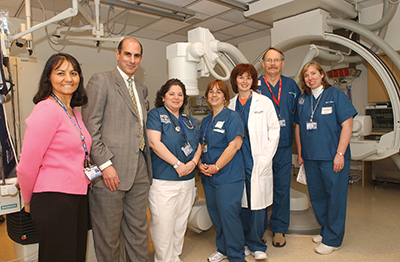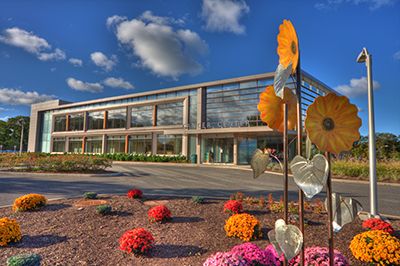2000
- The Long Island Cancer Center, the first comprehensive oncology treatment, education and research institute on Long Island, opens in September.
2001

A model of the Major Modernization Project, which called for significant expansion and renovation of the facilities at
Stony Brook University Hospital.
Stony Brook University Hospital.
- Bruce Schroffel becomes the hospital’s new Director and Chief Executive Officer.
- A major modernization plan is developed. The master plan calls for a new Orthopaedics Unit; a new Heart Center; expanded Emergency Department; construction of a freestanding Ambulatory Surgery Center; a new Women and Infants Center, including a renovated Neonatal Intensive Care Unit (NICU), Labor and Delivery suites, ante- and postpartum units and newborn nurseries; new Operating Rooms; construction of a freestanding Ambulatory Care Pavilion; and renovated and expanded cafeteria and lobby area.
- The hospital receives Long Island’s first digital mammography unit.
- Landmark surgery takes place when a total of five distinct heart procedures are performed during a single operation.
- World Trade Center (WTC) Medical Monitoring and Treatment Program facility opens. Established immediately after the attacks on September 11, 2001, it is the only comprehensive and specialty care program on Long Island that meets the physical and mental needs of first responders.
- Hospital employs staff of 3,406; full-time medical staff totals 368 physicians.
- Operating budget totals $364 million.
- 3,500 babies are born.
2002
- Ambulatory Surgery Center opens.
- Neuromuscular Disease Center opens.
2003
- Wall-breaking ceremony takes place for construction of the new Heart Center.
- Pediatric Multiple Sclerosis Center opens — the first of its kind in the nation.
- The hospital and the School of Medicine join together to host the first Celebrate Excellence Gala to raise funds for cancer research. Carol M. Baldwin, one of the nation’s leading breast cancer crusaders, is named the inaugural honoree for the gala’s Patron Award.
- Splashes of Hope, a talented group of artists who paint “therapeutic murals” on hospital walls, dedicated one of their newest mural projects at Stony Brook University Hospital with an impressive mural of “The Wizard of Oz.”
- SUNY is awarded a patent for Stony Brook’s virtual colonoscopy software, giving patients a noninvasive cancer screening alternative thanks to technologies developed at Stony Brook University.
- Chris Pendergast and the Ride for Life make a $25,000 donation to support the ALS Center at the hospital when the nationally known ALS advocate from Northport stops at Stony Brook during his ride from Montauk to Manhattan.
- Paul C. Lauterbur, PhD, whose research conducted at Stony Brook University led to the development of magnetic resonance imaging (MRI), receives the 2003 Nobel Prize in Physiology or Medicine.
- The relocated and renovated Orthopaedic and Joint Replacement Center opens with a ceremony attended by more than 300 staff members, local officials and community members.
2004

Heart Center Open House
- Windows Cafeteria, with renovated and expanded dining services, opens on the fifth floor of the hospital.
- Pediatric Bone Marrow Unit, the only one of its kind in Suffolk County, opens.
- Phase I of the new Heart Center opens.
- The expanded Bone Marrow Transplant Unit opens, the only one of its kind in Suffolk County.
- A groundbreaking takes place for the construction of the new Ambulatory Care Pavilion, which will house the Long Island Cancer Center, the Carol M. Baldwin Breast Care Center, outpatient oncology services, a state-of-the-art imaging center and pain management services.
- Market Place Café opens on Level 5, providing expanded dining services.
- Stony Brook University Hospital and Central Suffolk Hospital in Riverhead form the University Hospital Alliance (UHA) to expand critical healthcare services in eastern Suffolk County. The alliance is the first affiliation between a SUNY teaching hospital and a community hospital.
2005
- In a rare procedure, two teams of surgeons at Stony Brook University Medical Center simultaneously reattach Arsenio Matias’ hands during an 11-hour surgery.
- Thanks to more than $7 million in grants from the National Institute of Occupational Health and Safety (NIOSH) and the American Red Cross, Stony Brook University Hospital expands clinical services and other services for 1,800 Long Island 9/11 first responders.
- Doctors at Stony Brook University Hospital successfully complete a rare, lifesaving combination of surgeries, rescuing triplets at 31 weeks, so they could then treat an unusual and potentially lethal cardiac condition in the mother. The case is hailed as a “medical miracle.”
- Dr. Richard N. Fine, a nationally renowned pediatric nephrologist and Chair of Stony Brook’s Department of Pediatrics, is named Dean of the School of Medicine.
- The National Pediatric Multiple Sclerosis Center at Stony Brook University Hospital, the first center of its kind in the nation, is named a Pediatric MS Center of Excellence™ by the National Multiple Sclerosis Society.
2006
- The relocation and construction of Stony Brook University Hospital’s helipad and adjoining parking deck is completed.
- Stony Brook University Hospital receives the highest approval rating for a teaching hospital cancer program by the American College of Surgeon’s Commission on Cancer.
- The Heart Center at Stony Brook University Hospital is the first and only facility on Long Island using the “TandemHeart” system — a percutaneous left ventricular assist device — for patients who are too ill to undergo life-saving procedures without circulatory support.
- Stony Brook University Hospital is recognized for becoming “mercury free” and receives the Making Medicine Mercury Free Award, a prestigious national honor from Hospitals for a Healthy Environment.
- The State of New York approves a comprehensive alliance between Stony Brook University Hospital and Eastern Long Island Hospital to bring new and strengthened clinical services to the North Fork of Suffolk County, including Shelter Island.
- The new name “Stony Brook University Medical Center” is introduced to refer to both Stony Brook University Hospital and the School of Medicine, reinforcing Stony Brook’s preeminent position as the region’s only academic medical center.
- Stony Brook University Hospital is one of only 28 hospitals in the nation and one of two in New York to offer a NICU Family Support Program.
- Stony Brook University Medical Center has been named a 2006/07 “Consumer Choice Award” recipient for the Long Island metropolitan area by National Research Corporation. The award identifies hospitals which healthcare consumers have chosen as having the highest quality and image in 186 markets throughout the U.S.
- Steven L. Strongwater, MD, becomes CEO of Stony Brook University Medical Center.
- As a way to provide medical students with competency-based training early on, Stony Brook University Medical Center’s Clinical Skills Center (CSC) opens. Built in the design of an actual clinic, the 6,000-square-foot facility uses a variety of real-time, interactive clinical experiences to facilitate the development and measurement of clinical skills and professional competencies for students and practitioners of the healing arts.
2007

Ambulatory Care Pavilion
- The new Ambulatory Care Pavilion opens, providing the ideal setting for team-driven, patient-centered care. The 65,000-square-foot facility houses Stony Brook Cancer Center, the Imaging Center, the Carol M. Baldwin Breast Care Center and the Pain Management Center.
- Stony Brook’s Department of Urology is ranked among the top 50 in the nation by U.S. News & World Report in its annual ranking of “America’s Best Hospitals.”
- Stony Brook University Medical Center becomes the first on Long Island and in New York City to acquire the da Vinci® S HD™ Surgical System, enabling surgeons to perform complex surgical procedures without making large incisions. The advantages for patients include significantly less pain and reduced blood loss, less scarring, shorter recovery time and, in many cases, better clinical outcomes.
- The ExacTrac (R) X-ray 6D System, a new image-guided radiotherapy system at Stony Brook University Medical Center, combines high-tech imaging with precision tumor-targeting capability, allowing cancer specialists to treat patients, including those with medically inoperable tumors, at high risk for surgery or who do not want surgical treatment.
2008

The opening celebration of the Major Modernization Project
- Stony Brook University Medical Center is selected by the Nassau-Suffolk Hospital Council to receive its inaugural “Excellence in Patient Safety Award,” recognizing the medical center’s distinguished achievements in patient safety and quality improvement in decreasing sepsis mortality.
- The Kidney Transplant Program reaches a milestone with its 1,000th kidney transplant on March 18.
- Stony Brook employees, community members and guests celebrate the unveiling of 154,000 square feet of new construction and 48,000 square feet of renovation, all part of Phase I of the Medical Center’s Major Modernization Project. The space includes a new wing, which houses the Women and Infants Center, an expanded Emergency Department and a state-of-the-art Surgical Suite with an OR Pharmacy.
- Stony Brook University Medical Center again receives the Consumer Choice Award by the National Research Corporation (NRC) in Modern Healthcare magazine.
- Stony Brook receives a “Quality in Palliative Care Leadership Award” from the National Consensus Project (NCP). Stony Brook is one of nine first-ever recipients of the award and the only academic medical center selected.
- As part of the Major Modernization Project, 10 operating rooms are constructed, bringing the total to 24. In a long-running tradition, Lawrence Hurst, MD, Chair, Department of Orthopedics, has the honor of performing the first surgery.
- The State of New York approves a comprehensive alliance between Stony Brook University Medical Center and Southampton Hospital, the third East End hospital to form an affiliation with the Medical Center, to facilitate new and strengthened services to the East End of Suffolk County. This brings to conclusion a measure set forth by the Commission on Health Care Facilities in the 21st Century (Berger Commission).
- On Dec. 18, the Emergency Department opens its doors to a new space featuring 33 private rooms, which includes 10 critical care rooms and a new trauma resuscitation area; a dedicated Radiology Suite with a 64-slice CT scanner and two digital x-ray rooms; a new patient entrance/drop-off zone; a new ambulance entrance; and the relocation of the Medical Control and EMS Transfer Office.
- Stony Brook University signs a licensing agreement with the Siemens Healthcare Sector of Germany for virtual colonoscopy technology at the University.
2009
- The ALS Association certifies Stony Brook’s ALS (amyotrophic lateral sclerosis) Comprehensive Care Center — the only one of its kind on Long Island — as its 34th Center of Excellence in the nation.
- Stony Brook University Medical Center acquires the Sensei™ Robotic Catheter Ablation System, used by electrophysiologists to treat atrial fibrillation, the most common heart arrhythmia, as well as a variety of other complex arrhythmias. It is the only medical center on Long Island — and one of only 37 nationwide — equipped with this advanced catheter technology.
- Stony Brook University Medical Center becomes the first hospital nationwide to sign a comprehensive green “Memorandum of Understanding” with the U.S. Environmental Protection Agency to reduce the hospital’s environmental footprint.
- The Department of Urology is ranked among the top 50 urology programs in the “America’s Best Hospitals” issue of U.S. News & World Report for a second time. Stony Brook is one of only four hospitals from New York State highlighted, and the only Long Island hospital so ranked in Urology.

